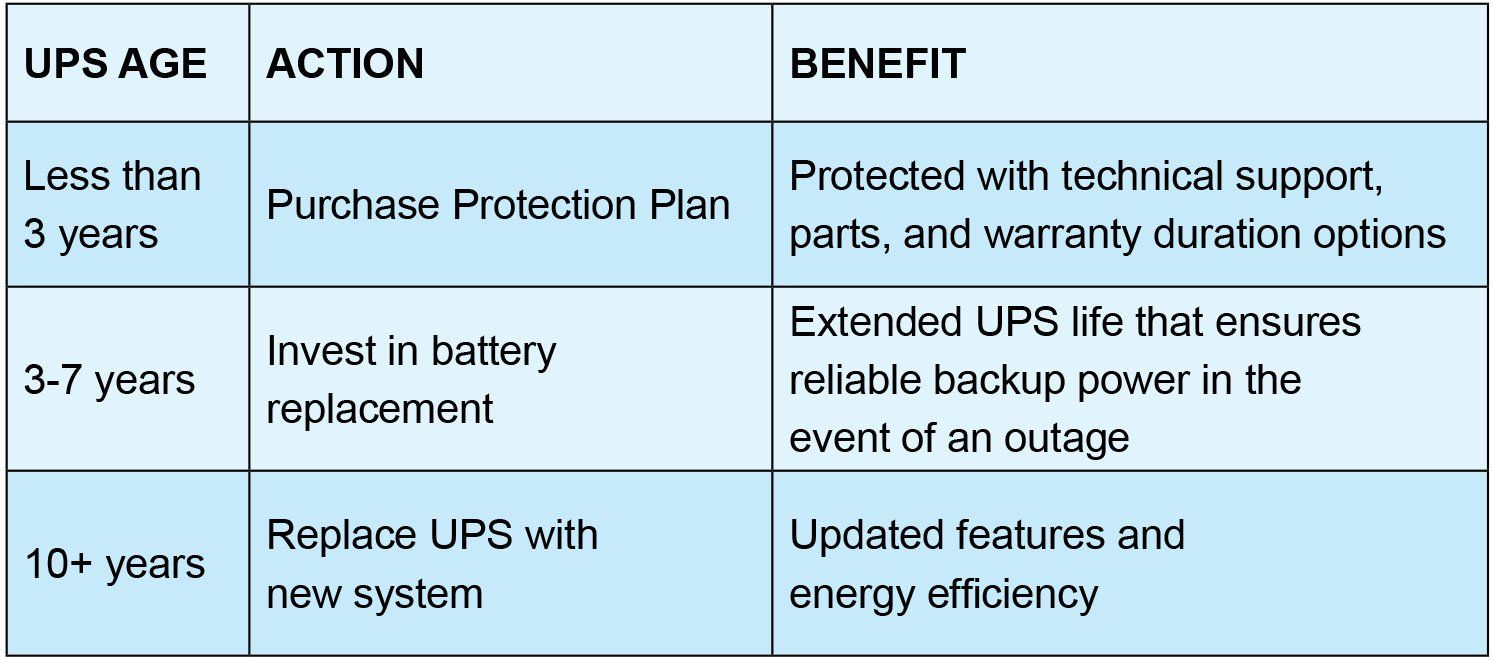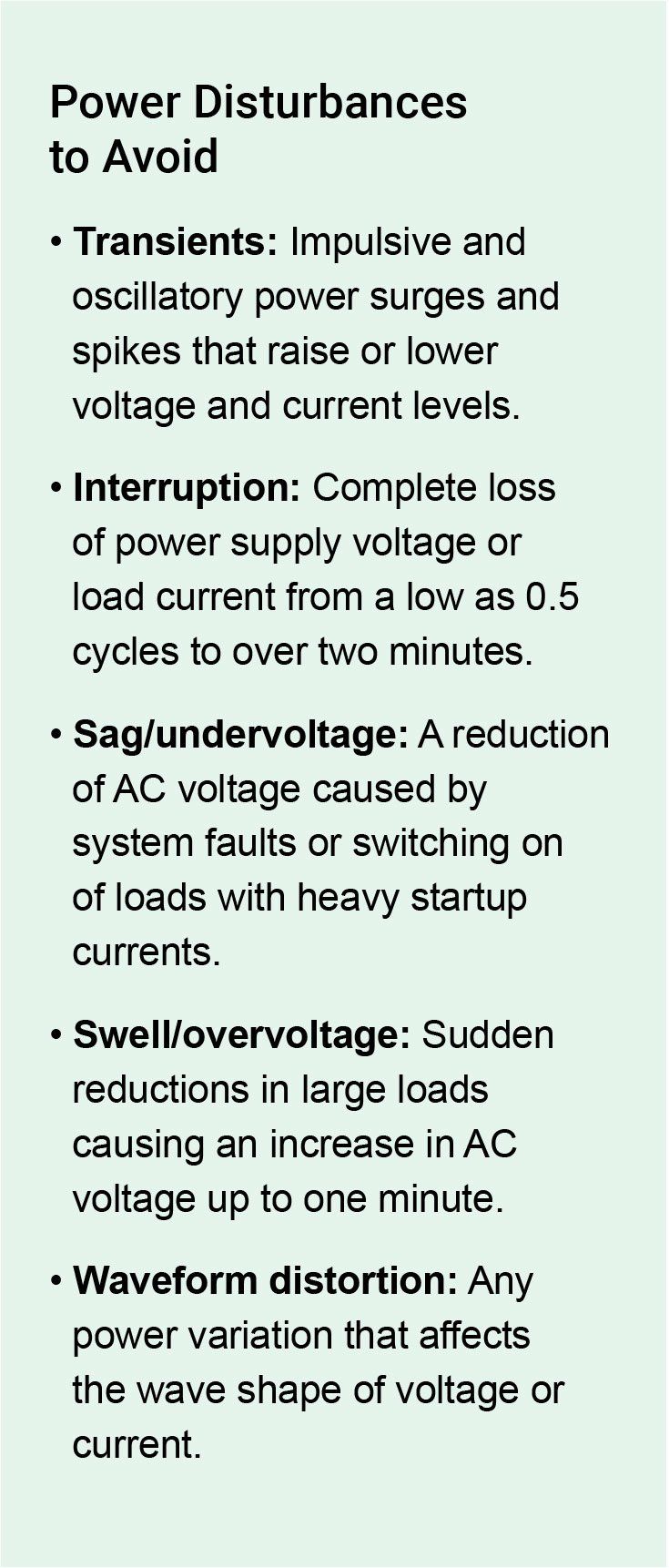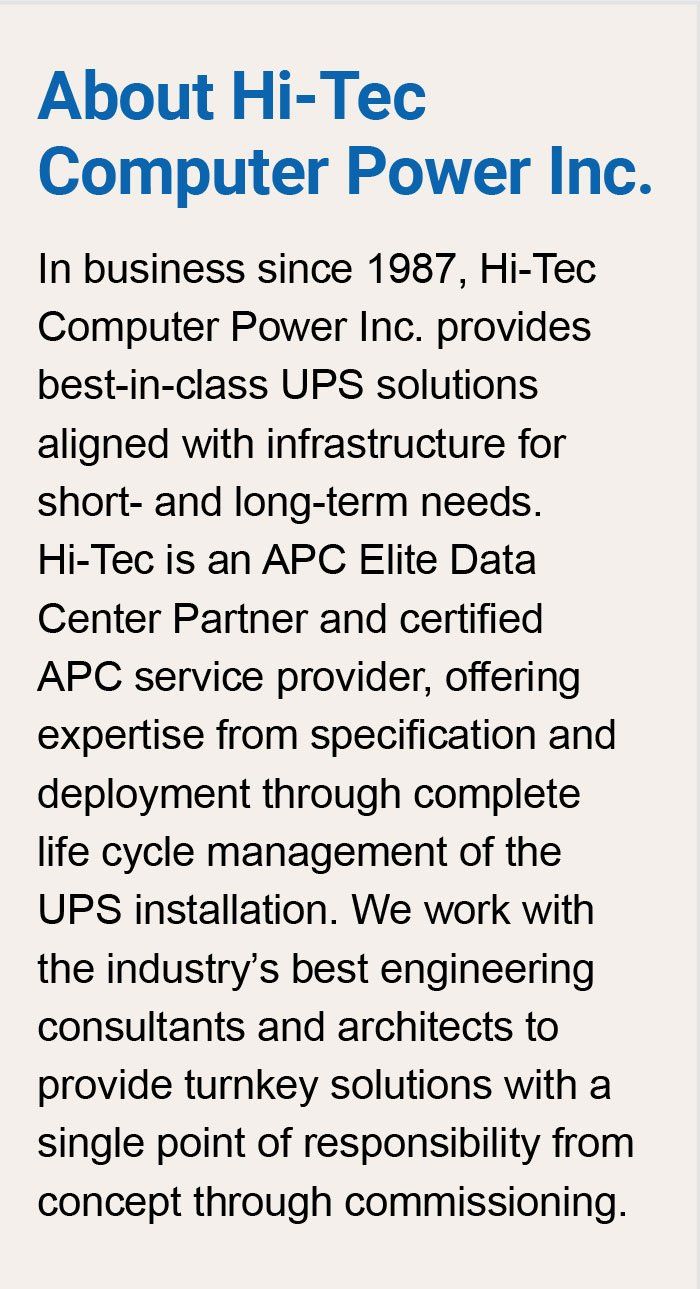Data Center Resiliency3 Ways to Power Data Center Advantagewith a Rightsized UPS Approach
Infrastructure modernization is creating a new demand for uptime and resiliency, as businesses make investments in initiatives that are mission-critical to workloads. Any amount of downtime can put a business at risk for financial damages, of losing stakeholder confidence, and of damaging its brand and reputation. Last-generation uninterruptible power supplies (UPS) are nearing their end of life, or simply aren’t architected to ensure the resiliency of today’s new IT initiates. This White Paper explores the best practices of infrastructure resiliency with rightsized UPS solutions, and the three ways they safeguard data center investments.
UPS as a Data Center Initiative
The demand for data center power is on, as modernization and investments in artificial intelligence, machine learning, virtualization, and the Internet of Things (IoT) call for server capacity powered by the data center. Not only are these technologies power hungry, but they’re finicky consumers, demanding steady, reliable streams of power to safeguard them from downtime or disruption.
Yet many companies still rely on legacy power solutions, choosing a “run-tofail” approach to UPS refresh instead of taking proactive upgrade measures. Once OEM support for UPS devices has ended, so too do the maintenance and recovery support. Repairs may require parts that are no longer available, causing maintenance costs over time to exceed the costs of installing a new system. The legacy UPS that the company relies on to power innovation is draining IT resources, unable to meet critical performance requirements. It is misaligned with a company’s present or future needs for UPS based on reliability, efficiency, and voltage conditioning.
Comparison of UPS System Benefits2

Top Contributors of UPS Life Expectancy2
Environment, management, and maintenance can impact UPS life expectancy.
- Placement or location
- Humidity and ambient temperature
- How often it cycles
- Type and frequency of maintenance
- Batter chemistry and storage
Power Disruption Impact on the Bottom Line
Data center requirements for power change from minute to minute, depending on computational load. The inability of UPS solutions to support these changes creates challenges in management and availability of power supply. Fluctuations in power consumption can lead to unplanned and undesirable consequences in the data center and network room environment, including tripped circuit
breakers, overheating, and loss of redundancy in power systems. It’s estimated that businesses lose between $104 billion and $164 billion per day to power interruptions and another $15 billion to $24 billion from other power problems.3
• Municipal Power Supply Risk. Utility power is 99.9 percent reliable in the
U.S., which may result in approximately nine hours of power interruptions
every year.4
• Voltage Volatility Disturbance. Voltage can legally vary from 5.7 percent to
8.3 percent under absolute specifications. This translates to an input voltage
that varies from 191 volts to 220 volts for utility services, which promise
208-phase voltage.4
U.S., which may result in approximately nine hours of power interruptions
every year.4
• Voltage Volatility Disturbance. Voltage can legally vary from 5.7 percent to
8.3 percent under absolute specifications. This translates to an input voltage
that varies from 191 volts to 220 volts for utility services, which promise
208-phase voltage.4
Most organizations can only handle 72 minutes of data loss per year when it
comes to high-priority apps.
3 Data Center Challenges Mitigated by a UPS Upgrade
1. Unplanned Data Center Growth
Monolithic UPS solutions sized for last-generation data centers can’t reliably meet new demand. Just as infrastructures are being architected for scale, UPS solutions should be configured to scale power and runtime as demand grows or as higher levels of availability are required. For some companies, products like the APC Smart-UPS® VT can ease rightsizing with compact, three-phase power protection with hot-scalable runtime to protect business-critical applications. This UPS scales from 10kVA to 40kVA and can be installed (and even rack mounted to save floor space) in small data centers, regional offices, and other IT environments with dense power
requirements — along with healthcare and manufacturing environments.
2. Changes in High Availability Due to Data Center Refresh
Companies of all sizes are embracing consumption-based infrastructure, moving away from large, monolithic data center configurations for smaller, modular building blocks of capacity that can be consumed as demand dictates. Their pay-as-you-grow architectures are highly efficient and affordable, avoiding the need to overprovision resources. One only needs to look at the rise in adoption of cloud, hyperconvergence, and software-defined everything as proof of this trend across the IT landscape.
Today’s UPS solutions are following suit. Modular UPS systems deliver more power in a small footprint, and hot-swappable UPS units allow for capacity to be added on the fly — with a low mean time to repair (MTTR) that assures high
availability. These systems can start small, giving businesses the ability to add
modules to increase capacity with efficiency and costs savings.
This modularity is ideal for small data centers, which now dominate the UPS market, contributing to more than 55 percent of revenue by 2020.4 UPS solutions right-sized for smaller data centers can be used for server rooms, factory floors,
industrial environments, localized and mid-tier data enters, and even medical imaging where scalable power and runtime are essential.
New-generation UPS solutions like those offered by APC™ by Schneider Electric are an example. The APC Symmetra PX power protection system offers high-performance, rightsized power protection that’s modular and hot scalable for ultra-high availability and efficiency for a wide range of data centers and high-density power zones. It can scale from 10kVA to 500kVA with dedicated
and redundant modules to ensure that adequate power is always available for essential connected systems.
3. Corporate Mandates for Operational Efficiency
Utilization of physical and power infrastructure in the data center is around 50-60 percent, costing businesses in operating, maintenance, and energy costs.8 This oversizing is an attempt to satisfy changes in infrastructure requirements but does so at the expense of efficiency. This can pose a problem to industries bound by efficiency mandates, like those in the public sector. For example, the Federal Data Center Optimization Initiative (DCOI) is a mandate from the Office of Management
and Budget (OMB) establishing levels of efficiency data centers must meet by the end of FY2018.9 This includes evaluating opportunities for consolidation, as well as looking at asset age and service history.
In the case of large enterprise data centers drawing high power costs with legacy UPS solutions installed a decade ago, new-generation UPS capacity can provide efficiency through reduced energy consumption. For example, the APC Galaxy VM lowers energy costs through high efficiency, while providing reliable backup power to medium data centers, industrial or facilities applications. This threephase UPS integrates into electrical, physical, and monitoring environments, with state-of-the-art electrical performance options, including wide input voltage range, high overload, and short circuit capacity. Efficiency is gained via a compact footprint, an ECOnversion mode, ECO mode, and double conversion mode, running as high as 99% efficiency while maintaining load protection.10
Conclusion
Reliance on last-generation UPS solutions can put data centers at risk for operational inefficiency and potential downtime if misaligned with new power demands. Investments in innovative technology require a constant, stable power supply with the ability to scale to meet changes in data center demand. UPS solutions older than 10 years should be upgraded to meet current requirements.
The new class of UPS solutions, such as the APC Symmetra line, provide scalable, modular options that can be rightsized as data center needs change. A pay-as-you-grow approach mitigates cost yet fully ensures that a UPS investment can deliver long-term business value.
Call (585) 223-5922 or email ted@hiteccomputerpower.com to learn more.
Our family owned company has
been providing network-critical physical infrastructure solutions to businesses
since 1987. Put our expertise to work for you!
$4.5B
The data center UPS
market is expected to
exceed $4.5 billion
by 2024.1

Most organizations can only
handle 72 minutes of data
loss per year when it comes
to high-priority apps.7





